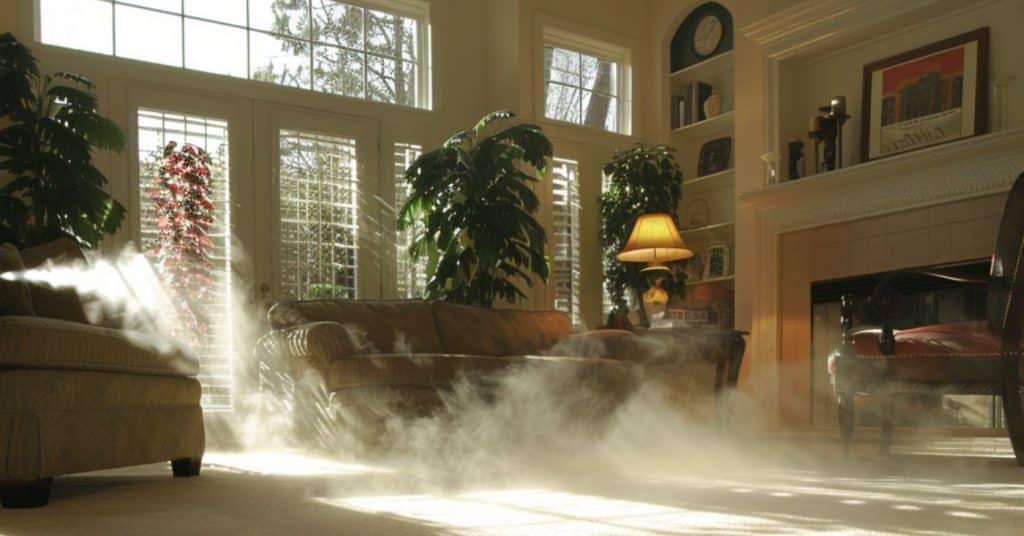After investing time and effort in steam cleaning our carpets, ensuring they dry properly is just as crucial. We all know the dampness left behind can be a breeding ground for mold and mildew, not to mention the discomfort of walking on a wet carpet. But how do we tackle this challenge efficiently to protect our carpets and keep our homes comfortable?
In our experience from providing carpet steam cleaning service in Melbourne, drying carpets after steam cleaning doesn’t have to be a daunting task. With the right approach and tools, we can speed up the drying process, ensuring our carpets are not only clean but also dry and fresh in no time.
The Importance of Drying Your Carpet After Steam Cleaning
Preventing Mold and Mildew
Let’s cut to the chase: Wet carpets are a breeding ground for mold and mildew. When carpets stay damp for too long, those pesky spores find a cozy spot to multiply, leading to musty odors and potential health hazards.
By effectively drying carpets post-steam cleaning, we dodge this bullet, maintaining a clean, healthy living space. It’s like ensuring your leftovers are sealed tight in the fridge; nobody wants a moldy surprise.
Preserving Carpet Quality
Imagine your carpet as your favorite t-shirt. Just as tumbling that shirt for too long in the dryer can harm its fabric, leaving your carpet wet for extended periods can degrade its fibers.
Adequate drying post-steam cleaning keeps the integrity of your carpet intact, preventing shrinkage, discoloration, and texture changes. We’re all about keeping that carpet feeling like the day you first met – fresh, soft, and perfectly intact.
Tools and Techniques for Drying Carpets
After steam cleaning, drying carpets becomes paramount to avoid issues like mold and damage to the fibers. We’ve covered why it’s critical; now, let’s dive into how to get those fibers fluffy and dry without a hitch.
Using Air Movers and Fans
The first trick in our bag involves cranking up air circulation. Positioning air movers and fans strategically around the room does wonders. Direct them so they blow across the carpet’s surface, effectively whisking away moisture.
Remember, the goal here is to create a breeze that covers as much area as possible. Don’t just point fans in one direction and call it a day; adjust them to ensure air reaches every nook and cranny.
Dehumidifiers: Reducing Humidity in the Room
Next up, we’re pulling out the big guns: dehumidifiers. These are especially handy in areas where the air feels like a wet blanket. By pulling moisture from the air, dehumidifiers make it less of a battle for the carpet to release that trapped water.
Position one in the room and set it to work. You’ll notice a significant drop in overall dampness, which is exactly what we’re aiming for. Not all heroes wear capes; some just silently draw moisture from the air.
Towels and Absorbent Materials
Last, but certainly not least, let’s talk towels. Not the fancy ones you keep for guests, but the ones you won’t mind getting down and dirty. Lay towels over the wettest areas and gently press down to absorb excess moisture. This method isn’t rocket science, but it’s effective for pulling water out of the carpet fibers.
Replace the towels as they become damp, and continue until they come up mostly dry. This low-tech solution can be surprisingly effective when used alongside the other methods.
By combining these tools and techniques, drying your carpet after steam cleaning becomes less of a chore and more of a surefire plan to protect your investment and health.
Best Practices to Speed Up the Drying Process
After steam cleaning your carpet, getting it dry is crucial to avoid any damage or unwanted smells. Let’s dive into some techniques to get that carpet dry faster, making sure your efforts in cleaning don’t go to waste.
Maximizing Air Circulation
First thing’s first: let’s talk about air circulation. Open those windows! Fresh air is your best friend in drying carpets. If the weather’s not on your side, don’t fret; fans work wonders, too.
Position them around the room, directing the airflow across the carpet’s surface. This helps moisture evaporate quicker. Remember, more airflow, less drying time.
Controlling Room Temperature
Keeping the room warm assists in evaporating moisture fast. However, turning up the heater isn’t always the answer. It’s more about striking a balance. A warm room speeds up evaporation but too hot, and it may well just feel like a sauna.
During the summer months, an air conditioner can help keep the room at an ideal temperature for evaporation without overdoing it.
Timing Your Cleaning: Choosing the Best Time of Day
Timing is everything, particularly when you’re trying to dry carpets. Aim for a time when you can leverage natural ventilation. Morning? Great for opening windows to let that breeze in.
Avoid evenings when humidity tends to rise. If you’ve got air conditioning or fans, though, you’ve got flexibility. They’ll help no matter the time of day.
How to Dry Carpet After Cleaning in Winter
Winter throws a curveball in our drying game. Opening windows may well not be an option unless you’re a fan of the chilly breeze indoors. Instead, rely on dehumidifiers and fans.
Dehumidifiers pull moisture from the air, which is a plus in damp conditions, and fans keep air moving over the carpet. It’s a teamwork effort that makes the drying dream work. Also, heating the house to a comfortable but not too hot temperature will encourage drying without turning your living space into a desert.
How Wet Should Carpet Be After Cleaning?
After cleaning your carpet, it should be only slightly damp to the touch. Here’s more to know:
How Long to Leave Carpet after Cleaning
After steam cleaning, everyone wants to walk on cleaned carpets again as soon as possible. However, quick drying is critical to avoid any damage or mold growth. On average, carpets should be left to dry for about 6 to 10 hours after cleaning.
This range can vary depending on air circulation, humidity levels, and room temperature. It’s key to allow carpets to dry thoroughly before resuming regular foot traffic. To speed up this process, nothing beats a good combination of air movers, fans, and a touch of patience. Remember, quicker isn’t always better if it compromises the carpet’s integrity.
Common Mistakes to Avoid When Drying Carpets
Drying carpets effectively after steam cleaning is pivotal in maintaining their condition and ensuring they’re ready for use without delay. In our experience, some mistakes can really throw a spanner in the works. Let’s dive into what not to do.
Over-Wetting the Carpet During Steam Cleaning
One of the classic blunders is soaking the carpet too much during the steam cleaning process. We get it, enthusiasm can sometimes get the better of us—but remember, a soggy carpet is a no-go.
Applying too much water doesn’t mean cleaner carpets; it means longer drying times and the potential for damage. Aim for damp, not drenched. A good rule of thumb is to go over each section just enough to clean it without leaving a mini lake behind.
Ignoring Humidity Levels in the Home
Humidity: the silent carpet drying saboteur. It’s easy to overlook, but air moisture levels play a big role in how quickly your carpet dries.
On muggy days, moisture in the air keeps your carpets wetter for longer, creating a lovely environment for mold and mildew to say hello. Running a dehumidifier in the room where the carpet is drying can make a big difference. It’s like telling humidity, “Not today, you’re not welcome here.”
Leaving the Carpet Too Wet for Too Long
Lastly, don’t leave your carpet wet for an extended period. We’re not saying you need to stand over it with a hairdryer (please, don’t), but don’t just clean it and forget it.
Wet carpets left unattended can become a breeding ground for unwanted guests like mold, mildew, and odors. This means your carpet might look dirtier after cleaning.
Thus, after cleaning, taking active steps to dry it—using fans, opening windows, or cranking up the air conditioning—helps avoid these issues. Think of it as tucking your carpet in for a cozy, quick dry-off.
Professional Vs. DIY Drying Methods
After steam cleaning your carpet, getting it dry is critical to avoid mold, mildew, and damage. Let’s dive into when to call professionals and how to do it yourself effectively.
When to Call in the Professionals
Sometimes, the job requires a bit more than what we have at our disposal. If your carpet remains damp for more than 24 hours after steam cleaning, it’s time to call in the professionals. Large areas, thick carpets that absorb a lot of moisture, and rooms with poor ventilation complicate the drying process.
Professionals bring in industrial-grade equipment like powerful air movers and dehumidifiers, which far exceed the capabilities of household fans and dehumidifiers. Plus, they’ve got the know-how to speed up the drying process without risking damage to your carpet or underlay.
Tips for Do-It-Yourself Drying
But hey, not every situation needs the cavalry. For those of us who like to tackle things head-on, here are some DIY drying tips that can do the trick:
- Keep the Air Moving: Position fans strategically around the room to promote air circulation. If it’s a sunny day, open windows to let in the fresh air but keep an eye on the humidity outside.
- Use a Dehumidifier: Place a dehumidifier in the room to help pull moisture out of the air. This is especially helpful in areas with high humidity.
- Towel Dry: Blotting the carpet with towels can remove surface moisture, which helps prevent mold from taking root.
- Lift the Carpet: If possible, lift the edges of the carpet to air out the underlay. Sometimes moisture gets trapped underneath, and airing it out can drastically reduce drying times.
Whether you decide to do it yourself or call in professionals, the goal remains the same: a dry carpet as quickly as possible. By understanding both approaches, we can make an informed decision based on our specific situation. Remember, the faster your carpet dries, the sooner you can enjoy your clean, fresh space again.
See more:

